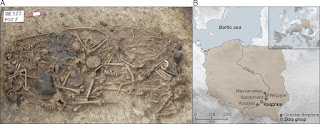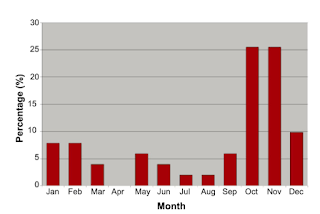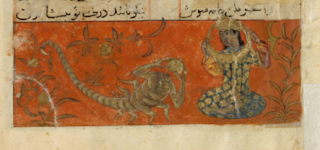The other day I came across the article entitled: "Unraveling ancestry, kinship, and violence in a Late Neolithic mass grave". It talks about the discovery of a very strange grave, during the 2011 archaeological excavations conducted on site 3 in Koszyce, Poland.
The first grave contained the remains of 15 individuals of various ages and both sexes.
Plague victims? Like the people from the grave from the same time period from Sweden? The one I talked about in my post "Burned house horizon"?
Nah. These people from Poland were brutally murdered. Bone examination showed numerous unhealed injuries on the skeletons, mostly traces of skull strikes. Each of the victims got up to four blows to the head probably with an axe...
You can read the detailed forensic analysis of the bodies in the article entitled "Evidence of interpersonal violence or a special funeral rite in the Neolithic multiple burial from Koszyce in southern Poland – a forensic analysis"...
The two smallest children's skulls were almost completely destroyed, indicating that the kids were held by their legs, and their heads were smashed against something hard, a stone or a tree...
Almost complete absence of upper limbs damage and injury character indicate that these people did not defend themselves. They were executed rather than killed in battle. But then they were buried with rich burial goods...
Placed into the grave with the bodies were many pottery vessels, flint axes and other flint artifacts, bone tools, boar tusks, amber ornaments, bone pendants and animal bones...
And close to the human grave, an animal burial was discovered, which contained skeletal remains of seven pigs...
This originally "completely threw" the archaeologists...They could not imagine the scenario that could explain such a "bizarre" burial...Except of course "a ritual"...
Apparently, according to Gimbutas: Globular Amphora culture classed social structure and the dominant position of men is demonstrated by richly equipped graves which contained astounding numbers of sacrificed human beings and animals...
...In such graves, the chief adult male occupied the central position in the stone cist and was accompanied into the afterlife by family members, servants, animals...
But of course, what we find in this grave in Koszyce is not such a ritual burial of a "dominant male" with "many sacrificed family members, servants and animals"...
Actually this burial makes me wonder if the "identification" of Globular Amphora culture burials as such, is just a loads of bollocks and none of them are in fact ritual burial of a "dominant male" with "many sacrificed family members, servants and animals"...
When genetic analysis of the remains was done, scientists identified four nuclear families in the grave, for the most part represented by mothers and their children...
Closely related kin were buried next to each other: a mother was buried cradling her child, and siblings were placed side by side...
These people were buried by someone who knew them well and who carefully placed them in the grave according to familial relationships...
For example, the oldest individual in the grave, was buried close to her two sons, whereas a 30–35-y-old woman, was buried with her teenage daughter and 5-year-old son...
Interestingly, the older males/fathers are mostly missing from the grave, suggesting that it might have been them who buried their kin. Only one father is present in the grave, and his partner and son are placed together opposite him in the grave...
In addition, there is a young boy, aged 2–2.5 years, whose parents are not in the grave, but he is placed next to other individuals to whom he is closely related through various second-degree relationships...
Finally, there is an adult female, who does not seem to be genetically related to anyone in the group. However, her position in the grave close to a young man, suggests that she may have been as close to him in life as she was in death...
This archaeological site tells a terrible story. While most men (and some women) were away from the settlement, working in a field, foraging, hunting, herding animals...A band of armed men (and most likely women) came into the settlement...
Considering that there were no signs of fighting injuries, these people could have even been welcomed by their victims who could have known them as neighbours. The villagers were then captured, held or tied, and executed, one by one...
The murderers then most likely plundered the settlement and left...Why do I think this is what probably happened here? Because the same things were still happening in Europe (Balkans) as late as the 20th century...
People from neighbouring villages killing their neighbours, men, women and children in most brutal ways, and then plundering their homes, and even moving into them...Like what happened in Serbian village of Prebilovci in Bosnia in 1941...
We don't know why this terrible crime was committed in Koszyce...Was it the hatred of "them" because they are different from us (look different, speak different language, pray to different gods)?
Or was it pure greed and material gain that motivated the murderers? One of those "capture the animals and beautiful women and kill the rest" raid, which could explain "some women missing from the pile of dead bodies". The fit ones...
We just don't know...But it is very likely that they were murdered by their neighbours coming from the villages of the Corded Ware culture...
What we know is that when the men (and women) who were away returned to the settlement and found their loved ones butchered, they decided to give them "proper burial"...Only the one who knew the victims intimately could have arranged the bodies in the way they were arranged...
And only the one who cared about the victims would have "equipped them for the journey to the otherworld", with jewellery, tools, weapons, food and water (contained in vessels placed next to the bodies) and animals (the pigs placed in the separate grave next to the human grave)...
This burying of animals with the dead, so they can have animals in the otherworld seem to have been a common practice in Central Europe during Copper and Bronze age...I talked about this in my post "Group portrait"...
The Koszyce archaeological site shows I was probably right when in this article entitled "One for the road" I suggested that if we want to understand ancient burial rituals in Central Europe, all we have to do is look at current burial folklore practices in the same area. Not much has actually changed...
This archaeological site also shows how genetics is cool, and how it is "improving" archaeology. Not just because by determining the relationship between the buried people, we can now much better understand what happened in Koszyce 5000 years ago...
But also because of this: All males carried the same Y chromosome haplotype: I2a. So did all the other male individuals found buried in the Globular amphora culture graves. They all carried I2a genes...How is this improving archaeology? Like this: It wrecks havoc in the field...
Marija Gimbutas in "The Indo-Europeanization of Europe: the intrusion of steppe pastoralists from south Russia and the transformation of Old Europe" hails the Globular Amphora as an "exemplary Indo-European steppe male dominated warrior culture"...
She says that: "It is apparent that the emergence of the Globular Amphora culture in the north European plain (around 3400BC) is crucial to an understanding of the Indo-Europeanization of this part of Europe"...
She also says that: "The fact that the Globular Amphora culture is so homogenous suggests that if these people were indeed IE speakers, they completely succeeded in subverting the indigenous population or in converting them to their own creeds, customs, and language"....
Ah I am so sorry that she is not around any more...It turns out that Gimbutas was soooo sooo wrong about the Globular Amphora culture. They have nothing to do with steppe "Indo-Europeans". They were a forest culture of the mountainous Central Europe...
The fact that their economy was based on raising mostly pigs in its earlier phase, is a dead giveaway that they didn't come from the steppe...Pigs live in forests...Steppe people were cattle and horse herders...
Gimbutas and co must have known this...Or should have known it anyway...
But what they didn't know, cause they couldn't have known it at the time, is that all the macho warrior patriarchal males of the Globular Amphora culture carried I2a genes. The earliest I2a genes in Central Europe were found in Mesolithic Lepenski Vir culture in Serbia, and predate the arrival of the Neolithic farmers...
So the I2a people watched the arrival to the Central Europe with Neolithic farmers. And they watched the arrival to the Central Europe of the Kurgan people. And these people are still in Central Europe...
Here is even cooler result of the latest genetic data. Gimbutas also says that: There is similarity between the burial rites of the Globular Amphora people and those of the "Kurgans of the Maikop culture" in the North Pontic region.
Both used mortuary houses built of stone slabs and practiced the ritual burial of horses, cattle, and dogs, as well as human sacrifice in connection with funeral rites honoring high-ranking males...
According to Gimbutas, Maikop people were "part of the Kurgan II invasion wave"...Guess what haplogroups were found inside the "Kurgans of the Mayop culture"? G2a, I2a, R1a, J2a1b...
G2a and I2a were two dominant haplogroups of the late Neolithic, Copper Age central Europe...
Remember the article I wrote about the origin and spread of the Megalithic culture through Europe, the one entitled "Childe was right"?
In the comments someone asked me "What about Russian dolmans?" These things:
Well Russian dolmens, which were built between the end of the 4th millennium and the beginning of the 2nd millennium BC. are concentrated around, guess??? Maykop culture territory...
As the new data shows that the Megalithic culture seem to have spread rapidly across Europe, most likely by the people of the same tribe, people linked to seafaring, mining...and Russian dolmens are also located on the coast. Of the area rich in ores...
And as we can read in the article entitled "Megalithic tombs in western and northern Neolithic Europe were linked to a kindred society": "males from megalith burials belong almost exclusively to YDNA haplogroup I2a"...Interesting...
So did Maykop people start building Megalithic "mortuary houses built of stone slabs" under the influence of I2a people from central or western Europe?
Did these I2a people arrive to Caucaus by land from Central Europe, more specifically Balkans, together with G2a people? After (or maybe before) the Balkan Neolithic collapse (4000 BC)?
Remember my article "Vinča warriors" in which I asked if we should look for the origin of the militaristic Copper and Bronze Age societies in Neolithic Central European cultures, like Vinča culture...Does this figurine group from Vinča settlement Stubline depict an army? Or at least and armed mob...
Or did they arrive by sea, from Mediterranean, where we find I2a and G2a people spreading together along the coast. Here is a study entitled "Ancient DNA reveals male diffusion through the Neolithic Mediterranean route" which shows that these guys were spreading together along Mediterranean coast around 3000 BC...
By boat? By boat. Did they also bother checking the Black Sea coast too? I mean this is right around the time when Russian dolmens are beginning to be built...In the Mykop territory...
I talked about Neolithic seafarers in Mediterranean and Atlantic, who were linked to Neolithic miners in my posts "Neolithic seafarers" and "Giant's ring"...
Were they the "prospectors, missionaries" that Childe talked about who spread the Megalithic culture wherever they went looking for stones and then metal from which to make tools and weapons?
The "Kurgan" Maykop culture (3700 BC–3000 BC) guys were mad about making metal weapons and were very good at it (the most ancient bronze sword on record, was made by Maykop people), were also a male dominated society...How did they learn their craft?
You know how copper and bronze metallurgy was invented in the Balkans? Mining and metallurgy are difficult things to figure out yourself and are much easier learned from someone who already knows how to do it...
Like emigrant metallurgists from the Balkans (G2a and possibly I2a) who left during the Balkan Neolithic collapse??? Or earlier???
And did these I2a and G2a people, produce Mykop Kurgan culture, after mixing with other people from the Steppe and Caucasus?
So who invaded whom? Did Caucasus people get Europeanised? What influence did these G2a and I2a people have on local cultures? Just technological? Religious? Cultural? Linguistic? Genetic definitely...
So, were Globular Amphora people product of "Kurgan" Maykop "invasion"? Or if there was a population movement from east to west (I talked about this in my post "Not so mobile riders"), was this in fact more like a "going back home to visit the relatives" kind of trip?
Because, there is a big problem with Maykop guys undertaking any mass long distance invasions...
Just like Balkan Neolithic people and Cucuteni-Tripillia people, Maykop people lived sedentary lives...
They were farmers who built terraces for growing their crops...People who build terraces don't go invading countries thousands of miles away...
But Maykop guys sold loads of its metal stuff to their Yamna neighbours. The Maykop guys also taught their Yamna mates a thing or two about how to mine, smelt and cast metal. Into weapons...Some of the Mykop guys possibly even joined the Yamna gangs...For a laugh...And profit...
Well not possibly. Definitely...Did you know that apart from dominant R1b genes (southern Yamna) and R1a genes (Northern Yamna), Yamna men also carried I2a genes? And so did some of the men of pretty much all the cultures surrounding Maykop and Yamna cultures...
How did these I2a guys (from Europe) end up there? And what influence, technological, cultural, linguistic, did these I2a guys (from Europe) have on all these "Indo-European" cultures? Which then "Indo-Europienised" Europe when they wandered (back) into Europe the 4th millennium BC???
So where does this leave Gimbutas theories? And the whole Indo-European thingy? It's a mess...And fun to watch...






















































































